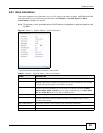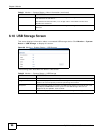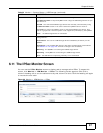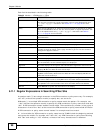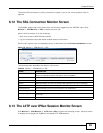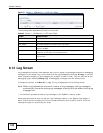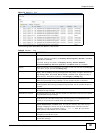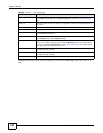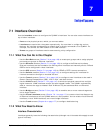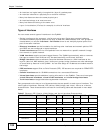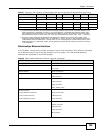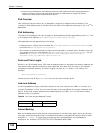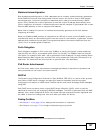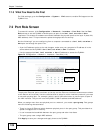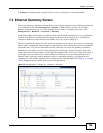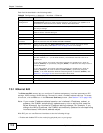
ZyWALL 110/310/1100 Series User’s Guide 103
CHAPTER 7
Interfaces
7.1 Interface Overview
Use the Interface screens to configure the ZyWALL’s interfaces. You can also create interfaces on
top of other interfaces.
• Ports are the physical ports to which you connect cables.
• Interfaces are used within the system operationally. You use them in configuring various
features. An interface also describes a network that is directly connected to the ZyWALL. For
example, You connect the LAN network to the LAN interface.
• Zones are groups of interfaces used to ease security policy configuration.
7.1.1 What You Can Do in this Chapter
•Use the Port Role screen (Section 7.2 on page 108) to create port groups and to assign physical
ports and port groups to Ethernet interfaces.
•Use the Ethernet screens (Section 7.3 on page 109) to configure the Ethernet interfaces.
Ethernet interfaces are the foundation for defining other interfaces and network policies. RIP and
OSPF are also configured in these interfaces.
•Use the PPP screens (Section 7.4 on page 125) for PPPoE or PPTP Internet connections.
•Use the Cellular screens (Section 7.5 on page 132) to configure settings for interfaces for
Internet connections through an installed 3G card.
•Use the Tunnel screens (Section 7.6 on page 140) to configure tunnel interfaces to be used in
Generic Routing Encapsulation (GRE), IPv6 in IPv4, and 6to4 tunnels.
•Use the VLAN screens (Section 7.7 on page 147) to divide the physical network into multiple
logical networks. VLAN interfaces receive and send tagged frames. The ZyWALL automatically
adds or removes the tags as needed. Each VLAN can only be associated with one Ethernet
interface.
•Use the Bridge screens (Section 7.8 on page 159) to combine two or more network segments
into a single network.
•Use the Virtual Interface screen (Section 7.9.1 on page 171) to create virtual interfaces on top
of Ethernet interfaces to tell the ZyWALL where to route packets. You can create virtual Ethernet
interfaces, virtual VLAN interfaces, and virtual bridge interfaces.
•Use the Trunk screens (Chapter 8 on page 177) to configure load balancing.
7.1.2 What You Need to Know
Interface Characteristics
Interfaces generally have the following characteristics (although not all characteristics apply to each
type of interface).



